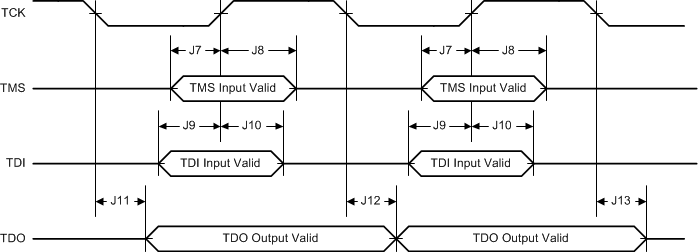JAJSE27 October 2017 MSP432E401Y
PRODUCTION DATA.
- 1デバイスの概要
- 2改訂履歴
- 3Device Characteristics
- 4Terminal Configuration and Functions
-
5Specifications
- 5.1 Absolute Maximum Ratings
- 5.2 ESD Ratings
- 5.3 Recommended Operating Conditions
- 5.4 Recommended DC Operating Conditions
- 5.5 Recommended GPIO Operating Characteristics
- 5.6 Recommended Fast GPIO Pad Operating Conditions
- 5.7 Recommended Slow GPIO Pad Operating Conditions
- 5.8 GPIO Current Restrictions
- 5.9 I/O Reliability
- 5.10 Current Consumption
- 5.11 Peripheral Current Consumption
- 5.12 LDO Regulator Characteristics
- 5.13 Power Dissipation
- 5.14 Thermal Resistance Characteristics, 128-Pin PDT (TQFP) Package
- 5.15
Timing and Switching Characteristics
- 5.15.1 Load Conditions
- 5.15.2 Power Supply Sequencing
- 5.15.3 Reset Timing
- 5.15.4
Clock Specifications
- 5.15.4.1 PLL Specifications
- 5.15.4.2 PIOSC Specifications
- 5.15.4.3 Low-Frequency Oscillator Specifications
- 5.15.4.4 Hibernation Low-Frequency Oscillator Specifications
- 5.15.4.5 Main Oscillator Specifications
- 5.15.4.6 Main Oscillator Specification WIth ADC
- 5.15.4.7 System Clock Characteristics With USB Operation
- 5.15.5 Sleep Modes
- 5.15.6 Hibernation Module
- 5.15.7 Flash Memory
- 5.15.8 EEPROM
- 5.15.9 Input/Output Pin Characteristics
- 5.15.10 External Peripheral Interface (EPI)
- 5.15.11 Analog-to-Digital Converter (ADC)
- 5.15.12 Synchronous Serial Interface (SSI)
- 5.15.13 Inter-Integrated Circuit (I2C) Interface
- 5.15.14 Ethernet Controller
- 5.15.15 Universal Serial Bus (USB) Controller
- 5.15.16 Analog Comparator
- 5.15.17 Pulse-Width Modulator (PWM)
- 5.15.18 Emulation and Debug
-
6Detailed Description
- 6.1 Overview
- 6.2 Functional Block Diagram
- 6.3 Arm Cortex-M4F Processor Core
- 6.4 On-Chip Memory
- 6.5
Peripherals
- 6.5.1 External Peripheral Interface (EPI)
- 6.5.2 Cyclical Redundancy Check (CRC)
- 6.5.3 Advanced Encryption Standard (AES) Accelerator
- 6.5.4 Data Encryption Standard (DES) Accelerator
- 6.5.5 Secure Hash Algorithm/Message Digest Algorithm (SHA/MD5) Accelerator
- 6.5.6 Serial Communications Peripherals
- 6.5.7 System Integration
- 6.5.8 Advanced Motion Control
- 6.5.9 Analog
- 6.5.10 JTAG and Arm Serial Wire Debug
- 6.5.11 Peripheral Memory Map
- 6.6 Identification
- 6.7 Boot Modes
- 7Applications, Implementation, and Layout
- 8デバイスおよびドキュメントのサポート
- 9メカニカル、パッケージ、および注文情報
Table 5-52 JTAG Characteristics
over operating free-air temperature (unless otherwise noted) (see Figure 5-40 and Figure 5-41)| NO. | PARAMETER | MIN | TYP | MAX | UNIT | ||
|---|---|---|---|---|---|---|---|
| J1 | fTCK | TCK operational clock frequency | 0 | 10 | MHz | ||
| J2 | tTCK | TCK operational clock period | 100 | ns | |||
| J3 | tTCK_LOW | TCK clock low time | tTCK / 2 | ns | |||
| J4 | tTCK_HIGH | TCK clock high time | tTCK / 2 | ns | |||
| J5 | tTCK_R | TCK rise time | 0 | 10 | ns | ||
| J6 | tTCK_F | TCK fall time | 0 | 10 | ns | ||
| J7 | tTMS_SU | TMS setup time to TCK rise | 8 | ns | |||
| J8 | tTMS_HLD | TMS hold time from TCK rise | 4 | ns | |||
| J9 | tTDI_SU | TDI setup time to TCK rise | 18 | ns | |||
| J10 | tTDI_HLD | TDI hold time from TCK rise | 4 | ns | |||
| J11 | tTDO_ZDV | TCK fall to data valid from Hi-Z | 2-mA drive | 13 | 35 | ns | |
| 4-mA drive | 9 | 26 | |||||
| 8-mA drive | 8 | 26 | |||||
| 8-mA drive with slew rate control | 10 | 29 | |||||
| 10-mA drive | 11 | 13 | |||||
| 12-mA drive | 11 | 14 | |||||
| J12 | tTDO_DV | TCK fall to data valid from data valid | 2-mA drive | 14 | 20 | ns | |
| 4-mA drive | 10 | 26 | |||||
| 8-mA drive | 8 | 21 | |||||
| 8-mA drive with slew rate control | 10 | 26 | |||||
| 10-mA drive | 12 | 14 | |||||
| 12-mA drive | 12 | 15 | |||||
| J13 | tTDO_DVZ | TCK fall to Hi-Z from data valid | 2-mA drive | 7 | 16 | ns | |
| 4-mA drive | 7 | 16 | |||||
| 8-mA drive | 7 | 16 | |||||
| 8-mA drive with slew rate control | 8 | 19 | |||||
| 10-mA drive | 20 | 22 | |||||
| 12-mA drive | 20 | 25 | |||||
 Figure 5-40 JTAG Test Clock Input Timing
Figure 5-40 JTAG Test Clock Input Timing Figure 5-41 JTAG Test Access Port (TAP) Timing
Figure 5-41 JTAG Test Access Port (TAP) Timing